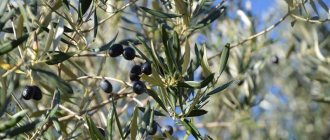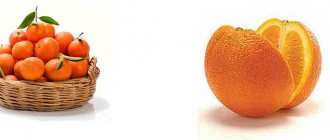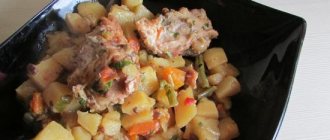Sesame (sometimes called sesame in Russian) is one of the most common food products in the East. There they call it differently - more “fabulously” - simsim (Arabic version). In English, sesame is called "sesame", and in Latin - "Sesamum Indicum".
Sesame seeds have been known to residents of India, China, Korea, Egypt and other eastern countries for several thousand years. And since humanity became acquainted with this wonderful plant, many recipes for delicious dishes and healthy potions have been invented. So the “Russian” perception of sesame seeds solely as a flavoring additive for sprinkling buns and bread, to put it mildly, is divorced from reality.
In ancient times, the belief in the healing properties of sesame was so great that it was “included” in the elixir of immortality, which, according to legend, fed the gods, and which could extend human life for many, many years. Apparently, since then, sesame has never left the list of “sources” of longevity, which is why even now in the east it is added to almost every dish. However, most of the “simsim” seeds these days are grown for a different purpose - namely, for the production of sesame oil, which is no less popular among chefs, doctors and cosmetologists than sesame itself.
Properties of sesame
Nutritional value and composition | Vitamins | Minerals
How much does sesame cost (average price for 1 liter)?
Moscow and Moscow region.
180 rub.
Sesame is one of the oldest types of seasonings, sometimes you can hear it called “sesame”. Sesame is a small seed that has a specific but delicate taste. Sesame is an annual plant, the fruits of which are oblong in shape, and inside them there are seeds, which are used as food. The color of sesame seeds varies; they can be yellow, white, brown or black. Sesame is often used not only in cooking in different countries, but also for medicinal purposes; in addition, sesame oil is made from it.
In ancient times, sesame was considered one of the ingredients of a certain potion that brought longevity to the inhabitants, and the inhabitants of ancient Babylon believed that sesame was the food of their gods. In the Middle Ages, the following phenomenon was common among women: they had to chew a spoonful of sesame seeds a day; it was believed that this had a beneficial effect on them. In eastern countries, sesame is probably the most common product, because it is used in the preparation of almost all dishes. Today, sesame is grown in different parts of the planet, including such places as Transcaucasia, India, and the Far East.
Contraindications
Sesame has a number of contraindications. Its use may cause significant harm to people with:
- increased blood clotting;
- tendency to thrombosis;
- the presence of kidney stones.
The product can be stored at room temperature for no more than 3 months, in cool storage for up to 6 months.
When frozen, quality indicators remain normal for about one year. But the oil can be stored for years, and environmental conditions do not affect it in any way. Even being in the sun, its beneficial composition will not be lost.
Benefits of sesame
The benefit of sesame is that oil is made from it. The beneficial properties of sesame are due to the content of essential oils - antioxidants called semazol and semazinol. Other products cannot boast of the presence of such strong substances in their composition, and if such products are found, the amount of semazole and semazinol is extremely small. It is thanks to these two antioxidants that sesame oil can be stored for quite a long time. The benefit of sesame is also that it contains a large amount of protein, as well as many polyunsaturated fatty acids (PUFAs), which determine the beneficial properties of sesame. It is with the help of these two components that sesame has the ability to influence the reduction of cholesterol levels in the blood.
Sesame contains many different vitamins, amino acids, minerals and nutrients, which together give a person vigor and health. Sesame contains fiber, which helps the intestines with its difficult work. Properly processed sesame seeds can provide significant help in case of constipation, and boiled sesame seeds, on the contrary, will help stop diarrhea. Ancient healers used sesame in medicine to relieve a person from a cold or infection. Sesame seeds and oil are often used by cosmetologists in various procedures or in the manufacture of cosmetics. The calorie content of sesame seeds is quite high, so with moderate consumption you will maintain your figure while gaining a lot of energy.
Dishes
Sesame seeds are good on their own. To get maximum benefits for the body, they should be consumed soaked. By the way, it’s even more convenient to chew them this way, since the shell gets wet. For digestion and assimilation, soaked grains are also more successful. But roasted seeds are not so healthy: under the influence of heat treatment, some of the beneficial properties are destroyed.
Manufacturers of sweets and bakery products have a special love for sesame grain. The following products are considered the most popular among consumers:
- Dragee peanuts in honey with sesame – calorie content 528 kcal per 100 g.
- Grilled cookies with sesame – calorie content 370 kcal per 100 g.
- French cracker Yashkino with sesame – calorie content 471 kcal per 100 g.
- Bun with sesame seeds “Pletenka” - calorie content 283 kcal per 100 g.
- Biscuits with sesame – calorie content from 374 kcal per 100 g.
- Manifesto breadsticks – 404 kcal per 100 g.
- Croisette rye-wheat bread with sesame – calorie content 397 kcal per 100 g.
Among fans of oriental cuisine, sesame paste, also known as tahina or tahini, has become widespread. The paste has a smooth consistency, so the jar must be shaken before direct use. Due to the high protein content in pasta, it can easily be used as an alternative to meat, which is valuable for vegetarians and during fasting. The taste of tahini is unique but pleasant, with a slight hint of bitterness. The calorie content of tahini per 100 g is 586 kcal.
They try to cook tahini at home, but this is not entirely correct. The fact is that industrial paste is a by-product obtained by cold pressing sesame grains during the oil production process. Homemade tahini is thicker.
In general, sesame is often found in home cooking recipes:
Kozinakov
In the classic recipe, kozinaki is a dish based on nuts and honey. Today, in addition to the traditional delicacy with walnuts, you can find other types of it. Industrially produced sesame kozinaki contains sugar syrup or molasses instead of honey, which is why they are considered a high-calorie product - at least 510 kcal per 100 g. The calorie content of homemade dessert is lower - 480 kcal per 100 g, but the main difference is the use of natural ingredients.
70 grams of white sesame seeds are poured into a hot frying pan and fried until golden brown for 2-3 minutes (stirring constantly). In another frying pan, melt 1 tablespoon of granulated sugar and 70 ml of honey. The resulting homogeneous mass is combined with cooled sesame seeds and quickly mixed. The oven sheet is covered with parchment. Lubricate with water and spread the mixture. Level with a spatula. Leave at room temperature for 3 hours, then allow to cool in the refrigerator for 15 minutes. Before serving, cut the leaf with a cold knife.
You can also prepare kozinaki based on sesame and flax. Soak 70 g of raisins in cold water for an hour, and 130 g of dates for 3 hours. Then the seeds are removed from the dates and crushed using a blender, adding a little water. Mix date puree, raisins, 200 g sesame and 100 g flax seeds. Stir. Spread the mass in an even layer on a baking sheet covered with parchment. Dry in the oven until ready. The calorie content of 100 g of such kozinaki is 412 kcal.
Burfi
Sesame dessert burfi is a rather fatty and oily dish. It comes from India, where it sounds like “milk fudge.” The calorie content of burfi corresponds to the description - 584 kcal per 100 g, so you should not get carried away with it.
Melt 170 grams of butter in a saucepan with a thick bottom. Add 4 tablespoons of white sesame seeds and mix thoroughly. Fry for about 10 minutes, stirring the mixture constantly. Next, add 80 g of powdered sugar and mix with a whisk. Bring the mixture to a boil and carefully add 80 g of milk powder. If lumps form, break them with a whisk. Wait until the burfi becomes thick. Remove from heat, place in molds and leave for 15 minutes at room temperature, then put in the refrigerator.
Cookies
In most dishes, sesame is an auxiliary ingredient, and in homemade cookie recipes it plays almost the main role in terms of taste. Moreover, cookies can be not only sweet, but also salty.
Sand
Shortbread cookies are made from crumbly dough, which is generously sprinkled with sugar and sesame seeds, which gives it a delicate nutty flavor. The form can be any.
To knead the dough take:
- 2 eggs;
- 100 g white sugar;
- 200 g butter;
- 300 g flour.
The oil is heated to room temperature. Grind with sugar, then add one whole egg and the white of the second. Add flour and mix well. Then the dough is rolled out into a layer up to 8 mm thick. Cut out cookies. The blanks are placed on a baking sheet and placed in the freezer for 20 minutes. Afterwards, grease the surface of the cookies with yolk, sprinkle with sugar and sesame. Bake at 200 degrees for about 20 minutes.
The calorie content of every 100 g of cookies is 410 kcal.

Oatmeal
Cereal cookies are prepared with sunflower seeds and sesame seeds. It is recommended to choose the simplest oatmeal. Instant cereal is not suitable as it will make the dough sticky.
Blend 80 g of oatmeal with a blender until it becomes coarse crumbs. Mix 100 g of soft butter, 180 g of sugar and 50 g of sour cream in a glass container. Then add 90 g of flour, one chicken egg and a handful of broken oatmeal. Knead and reintroduce 90 g of flour, the remaining crushed flakes and 20 g of whole flakes. Mix thoroughly again. Knead the dough until it becomes plastic and oily. Next, the dough is placed in a plastic bag and placed in the refrigerator for half an hour.
The baking sheet is covered with parchment and greased with vegetable oil. The dough is taken out of the refrigerator, rolled into balls and pressed down, turning it into a flat cake. Place some seeds and sesame on top. Bake at 180 degrees for 25 minutes.
The calorie content of cereal sesame cookies for every 100 g is 441 kcal.
Banana
Sesame-banana cookies are fragrant and healthy, and are prepared in about 30 minutes.
Ripe banana is pureed in a blender. Transfer the mass into a container. Add 120 g of sugar, 1 tablespoon of lemon juice, 60 g of sour cream and 80 ml of vegetable oil. Add a little cocoa to give it a beautiful shade, and mix everything well. In a separate container, mix 400 g of wheat flour and 0.5 teaspoon of baking soda. Pour the bulk mixture into the liquid mixture and knead the dough thoroughly. The dough is then formed into cookies. Each is rolled in sesame seeds and placed on a parchment-lined baking sheet. Bake for about 15 minutes at 180 degrees.
100 g of finished cookies - 341 kcal.
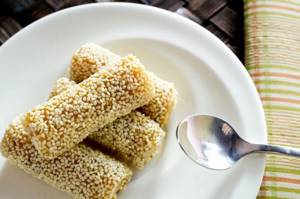
Cipollino
Already from the name it becomes clear that the cookies are prepared using onions. Sesame seeds go well with it. The cookies turn out to be “snack-like”, that is, they are good for a snack.
100 g green onions, finely chopped. 50 g of rye bran is ground in a coffee grinder, 50 g of sesame grains are fried in a dry frying pan. In a deep container combine bran, sesame seeds, 3 g of salt, 260 g of wheat flour, 7 g of baking powder and 100 g of butter. Add green onions. Knead the dough. Roll out to a thickness of 1 cm and cut as desired. Bake at 200 degrees for no more than 20 minutes.
The calorie content of Cipollino cookies for every 100 g is 319 kcal.
Fitness
These cookies can also be called “grilled” cookies, because they are prepared using nuts. An ideal dish for a hearty snack and replenishment.
In a deep container combine 200 g of oatmeal, 150 g of butter, 100 g of peeled sunflower seeds, 100 g of sesame seeds, 100 g of raisins, 150 g of crushed nuts, 150 g of sugar, 3 eggs and 100 g of flour. If desired, the dough can also be prepared with flax (add about 1 teaspoon). Mix everything thoroughly and knead the dough. Spoon the cookies onto a parchment-lined baking sheet. Bake for about a quarter of an hour at 200 degrees.
The calorie content of the finished cookies is 437 kcal per 100 g.
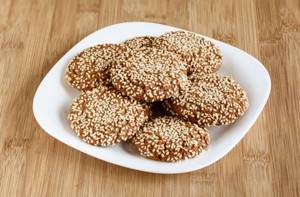
Cheese
Another cookie option for those looking for a healthy snack without the sweetness. This is an excellent choice for black coffee lovers. The cookies turn out thin and crispy, aromatic and satisfying.
150 g of hard cheese are grated and mixed with 80 g of softened butter. Add 100 ml of milk, 150 g of wheat flour and a pinch of salt to the mixture. 3 g of baking powder is also introduced. If desired, you can add some dried herbs. Knead the dough, roll it into a ball and put it in the refrigerator for half an hour. The chilled dough is rolled out as thin as possible. Cut into cubes or diamonds. Place the dough on a parchment-lined baking sheet. Sprinkle with sesame seeds dried in a frying pan. Place in an oven preheated to 200 degrees for 15 minutes.
The calorie content of cheese cookies with sesame is 360 kcal per 100 g. In 1 piece. There are not many calories, so cookies can be a good snack even during a diet.
Casseroles
The cottage cheese casserole is prepared using sesame flour rather than wheat, so it turns out very healthy and aromatic. The calorie content, taking into account the richness of the dish, is low - 186 kcal per 100 g.
150 g of 0% fat cottage cheese are ground with one egg. Add 60 g of flour and 30 g of steamed raisins. Knead. Spread the mixture into a baking dish. Keep in the oven for 30 minutes at 180 degrees.
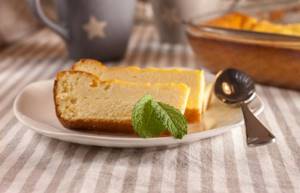
Of bread
Sesame bread is suitable for following the Dukan diet, specifically for the stages: alternation, consolidation and stabilization. Calorie content per 100 g – 199 kcal.
130 g of cottage cheese are ground with a pinch of salt and two chicken eggs. Add 1 teaspoon of baking powder, 4 tablespoons of oat bran and half as much wheat bran. Mix everything thoroughly. Place the mixture in a baking dish, level it and sprinkle generously with sesame seeds. Bake at 180 degrees for about half an hour.
Salatov
In salads, sesame seeds are used as a spice. If desired, they can diversify any recipe. The most profitable combinations look like this:
With avocado
Salad with avocado and sesame turns out appetizing even without dressing, but you can use lemon juice or olive oil as the latter. For those losing weight, light yogurt is a good choice.
Roughly chop 80 grams of Chinese cabbage, 60 grams of tomato, 60 grams of bell pepper and 30 grams of leek. 60 grams of avocado, peeled and also chopped. All ingredients are laid out on a dish in layers. Sprinkle a teaspoon of sesame seeds on top.
The calorie content of the salad is minimal - 68 kcal per 100 grams - so it looks like a good dish for a dietary table.
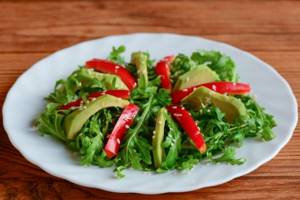
With cucumber
Summer salad is incredibly easy to make and quite filling.
3 medium-sized cucumbers, peeled and cut into small slices. 1 clove of garlic is passed through a press. Finely chop several branches of cilantro and dill. In a container combine 3 tablespoons of olive oil, the juice of half a lemon, 1 teaspoon of balsamic vinegar, ground black pepper and garlic. Combine cucumbers, herbs and dressing. Stir. Sprinkle with 1.5 teaspoons of sesame seeds.
Calorie content of 100 g of salad with cucumber is 107 kcal.
With beets
Beets are known for their cleansing properties. With the help of such a salad, you can be well fed during your diet and rid your body of “garbage” without the use of synthetic products.
One medium-sized beet is washed, dried, wrapped in foil and baked in the oven until tender. After cooling, peel and grind using a fine grater. 25 g of walnuts are fried in a dry frying pan. In a deep container combine beets, nuts, some sunflower seeds, and 1 clove of chopped garlic. Salt to taste. Season with a small amount of low-fat sour cream or light yogurt. Stir. Sprinkle with 1.5 tsp. sesame.
Calorie content of 100 g of salad to cleanse the body is 199 kcal.
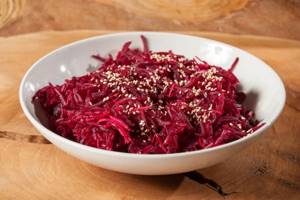
With cabbage
Bok Choy cabbage salad is crispy and light like spring. At the same time, it can fill you up without adding any calories to your diet.
Roughly chop 4 bok choy cabbage heads, 1 carrot, 2 celery stalks and 1 red hot pepper. Place in a container and mix. In separate containers, mix the dressing components: 50 ml olive oil, 15 ml sesame oil, 15 ml rice vinegar, 5 ml soy sauce, 5 ml liquid honey, a pinch of salt and ground black pepper. Dress the salad and sprinkle sesame seeds on top.
The calorie content of 100 g of salad with Bok Choy cabbage and sesame oil is only 27 kcal. Thanks to the use of celery, the dish turns out to be healthy in all respects and fills you for a long time.
With seaweed
Chuka salad (with seaweed) with sesame seeds is piquant and healthy. To prepare it, seaweed can be taken frozen or pickled. Quantity - 250 g. 1.5 tablespoons of sesame seeds are fried in a dry frying pan until golden brown. Transfer to seaweed. Add 50 ml of water and soy sauce, 1 teaspoon of sesame oil, lemon juice and starch. Stir.
Calorie content of 100 g of ready-made dish is 180 kcal.
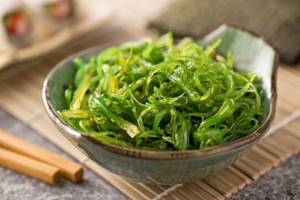
With feta cheese
Prepare vegetables: 4 tomatoes (diced), 4 bell peppers (straws), 4 peeled cucumbers (slices). Cut 1 bunch of basil and 150 g of cheese (in small cubes). Everything is connected. Drizzle with 4 tablespoons of olive oil and sprinkle with 3 tbsp. l. sesame seeds
The calorie content of salad with cheese for every 100 g is 103 kcal.
Drink
A drink with sesame seeds and dates is recommended to be included in the diet of vegetarians and those losing weight. It's easy to prepare. 50 g of dates are soaked in cold water for 3 hours. 50 g of sesame grains are also soaked for 2 hours. Then the dates are pitted. Combine the ingredients, add 0.5 tsp. cinnamon, blend with a blender. Pour in 0.5 liters of water and blend again with a blender. Strain through a sieve. Calorie content of 100 ml of drink is 72 kcal.
Sesame oil
Sesame oil has been known since ancient times. It is especially popular in Asian countries, where it is valued not only for its excellent taste, but also for its medicinal properties. When used externally, it rejuvenates the skin, restores the structure of hair, especially colored hair, and reduces its fragility.
It should be remembered that sesame oil is contraindicated for thrombophlebitis and varicose veins. You can also find information about the benefits of walnut and pine nut oils on the website.
Reviews from real people
What do people think about the properties of sesame?

Feedback on the forum

Feedback on the forum

Feedback on the forum

Feedback on the forum

Feedback on the forum
In fact, there are a large number of reviews, and they are all positive.
Application of ether
The use of sesame ether is recognized in traditional medicine. Emulsions, ointments, plasters and compresses are made from it. It improves blood clotting, has a mild laxative effect, and is used for chronic constipation and hemorrhoids. They do enemas with it to relieve intestinal inflammation.
The ether can be used not only as an external agent, but also internally. It is prescribed for stomach ulcers, to remove waste and toxins from the body.
- nourish and soften the skin;
- remove inflammation;
- accelerate healing;
- eliminate redness.
Various cosmetics are prepared on its basis: masks, creams, tonics. Regular use of sesame oil allows you to forget about problem skin forever. It is often used as a sunscreen.
The oil product contains a large number of calories, so it is not recommended to add it to food while losing weight. In total, sesame oil contains 894 kcal per 100 ml, BZHU ratio: 15/79/0.
Traditional medicine
The use of sesame for medicinal purposes should be agreed with a doctor.
Traditional recipes:
| Problem | How to use |
| Long-term acute respiratory viral infections or acute respiratory infections with cough and runny nose | Steam the sesame ether and rub it into the sternum area, wrap it in a warm scarf. |
| Infertility | Representatives of both sexes eat 1 tablespoon of grains per day, pre-soaked in water, chewing thoroughly |
| Ulcers, gastritis, chronic constipation | Take sesame ether 1/2 tablespoon three times a day with a small amount of liquid. You can season salads with it |
| Obesity | Eat sesame flour in the amount of 1 tablespoon 3 times a day before meals. Drink plenty of liquid |
| Caries, gingivitis, periodontitis, tartar | Hold 1 tablespoon of the oil product in your mouth for 4 minutes. Then spit it out. For oral health, this procedure should be done daily after brushing your teeth. |
The healing properties of sesame, when consumed in moderation and in small doses, help to cope with depression, insomnia, apathy, and restore the natural beauty and youth of the body.
And a little about secrets...
The story of one of our readers, Irina Volodina:
I was especially distressed by my eyes, which were surrounded by large wrinkles, plus dark circles and puffiness. How to completely remove wrinkles and bags under the eyes? How to deal with swelling and redness? But nothing ages or rejuvenates a person more than his eyes.
But how to rejuvenate them?
Plastic surgery? I found out - no less than 5 thousand dollars. Hardware procedures - photorejuvenation, gas-liquid peeling, radio lifting, laser facelift? A little more affordable - the course costs 1.5-2 thousand dollars. And when will you find time for all this? And it's still expensive. Especially now. That's why I chose a different way for myself... Facebook
Description
Sesame is also called sesame. This name translates as “oil plant” and comes from Greek and Arabic.
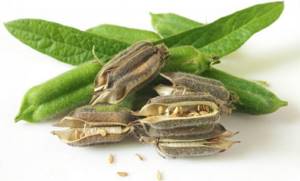
Sesame comes in several varieties and different colors: not only white and black, but also yellow, red, and brown. Most species grow in Africa. Indian sesame (sesamum indicum) is cultivated in the subtropics; it is a cultivated plant. This variety is used as a food product. Sesame seeds and sesame oil are widely used in Eastern and Asian cuisine.

